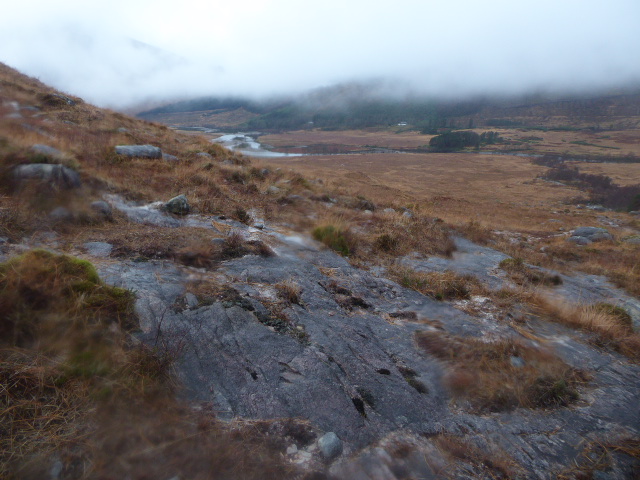
A number of people have been asking me about what is happening with the seven Glen Etive Hydro schemes which were approved by the full Highland Council in March. Until last month, it was difficult to answer. There had been no reports of activity on the ground and no further information had been added to the applications on the Highland Planning Portal. Then, on 12th August, an email from the Scottish Environment Protection Agency dated 10th June (see here) to the Applicant following a three way site meeting with Highland Council appeared under the title of “Condition 1 – pre-commencement” . It is both informative and worrying. This post is the first of two to take a look at the issues it raises and what this tells us about Scotland’s Planning System.
In August 2018 SEPA, the government agency responsible for pollution and our rivers, issued a 9 page letter in response to the original Glen Etive Hydro Applications (see here), which it helpfully summarised as follows:
Advice for the planning authority
The applicant kindly carried out pre-application discussions with us over the past few years. [NOTE – YEARS] .Unfortunately not all of our advice has been followed and therefore we have to object to this planning application on the grounds of lack of information and unless the Construction Method Statement (CMS) and site layouts are modified as detailed in Sections as detailed in Sections 2, 3, 4, 5 and 7 and the conditions detailed in Section 6 are applied. We will review this objection if the issues detailed below are adequately addressed.
And so they did when Dickins Hydro Resources, the Applicant for all seven hydro schemes, revised a number of documents: SEPA agreed to withdraw their objection if Highland Council imposed a number of conditions.
That is standard practice for Scotland’s Planning System as it currently operates. Instead of our public authorities addressing all the issues associated with a development before an application is approved, applications are approved on condition issues are addressed in future. Often this does not fully happen, which helps to explains the extent of the damage that has been caused by hydro scheme construction across the Highlands (see here for example). It is, therefore, very re-assuring to see SEPA state at the start of their email that they expect all the Etive sites to fully meet the requirements set out in the Planning Conditions specified by Highland Council:
“Our expectation is that all sites will be constructed in a way that ensured that they meet the requirements of the conditions outlined in the consents. If alternatives come forward then the full environmental effect of these needs to be assessed and it would need to be demonstrated that the alternative posed a similar or lower environmental risk than what has already been agreed.”
This, one might have hoped, would be fully understood by all hydro scheme developers as a matter of course. The reason SEPA had to spell this out, however, this soon becomes clear:
“Allt Chaorainn
·It was disappointing that much of the discussions at this site concentrated around the contractors views that it was not technically possible to construct the site in line with the conditions outlined in the consent. This shows the importance of including construction contractors in the planning process and employing a contractor who can meet the requirement of the consent. It’s clear William [Ed. William Dickins from Dickins Hydro Resources] that you need to discuss method of construction further with this contractor.”
So what experience does Dickins Hydro Resources, to whom the future of Glen Etive has been entrusted, have? (That, I will cover in my next post). And why did Dickins fail to consider whether the measures proposed to secure planning permission were actually practical or not?
Maybe the construction methods Dickins outlined could be implemented by another contractor? Ihave my doubts, for reasons which are further spelled out by SEPA:.
“Good turfs are going to be limited. All of them must be reused – and the sooner the better.” (see top photo).
So how is Mr Dickins going to restore the ground in Glen Etive in areas of shallow soils where there aren’t sufficient good turves? How is he going to prevent it ending up looking like Glen Bruar (see here) or the failed Beauly Denny powerline restoration where Scottish and Southern Electric blames what has gone wrong on shallow soils and shortage of vegetation (see here)? Is there any example in Scotland of major construction works on such soils and vegetation where restoration has been successful and, if so, how could that be applied to Glen Etive? This is a fundamental issue and, I believe, should have been addressed BEFORE planning approval was granted. If was easy to address, it would have been by now.
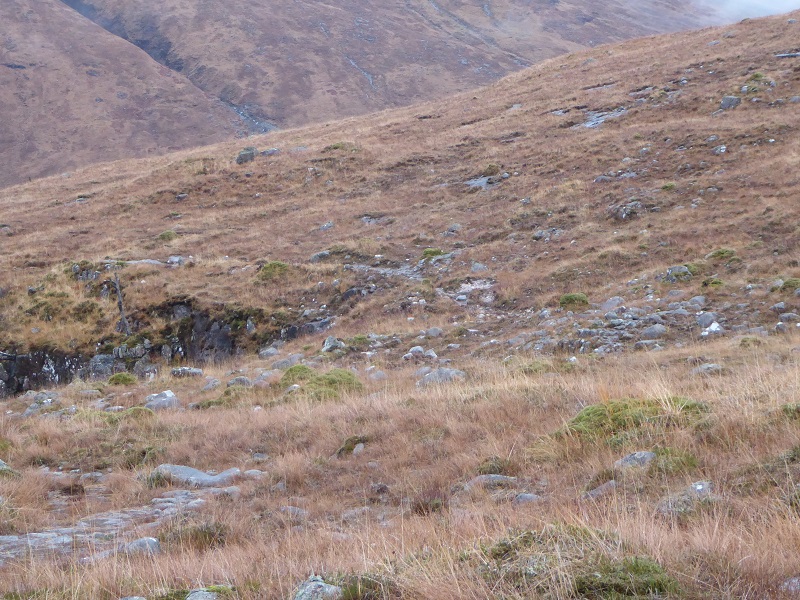
SEPA go on to say, in the context of the Allt Chaorainn scheme:
“it did seem that the most environmentally risky works (on the hill corner about 100 m below the intakes – NN 19888 50194) are located where bedrock is located and works will be slowest………………Further investigation is required relating to the extent of rock that will need to be
excavated before detailed layout designs and timing can be agreed. We would want to
see cross sections to show the extent of excavations required to get the corridor around
the hill corner referred to above.”
So, there still appears to be NO plan for how Mr Dickins proposes to cut the pipeline through the rock slabs which sit below the Allt Chaorainn intakes let alone how to restore this. There are similar chalenges on the Allt Mheuran – top photo – which was not included in SEPA’s site visit. Its reasonable to ask how a pipeline can be cut through slabs of rock without doing irreparable damage to the surface of the landscape? I personally can’t see how you can restore a glaciated rock slab once you’ve broken it up – you’d need to replace granite with textured concrete. Again, I believe this question should have been addressed BEFORE planning consent was granted and, if Dickins Hydro Resources failed to come up with satisfactory solutions, Highland Council should have required them to tunnel under the slabs (a far far more expensive option). They should still do this, if Dickins Hydro fails to come up with world beating quality plans for rock slab restoration.
SEPA goes on to highlight other issues:
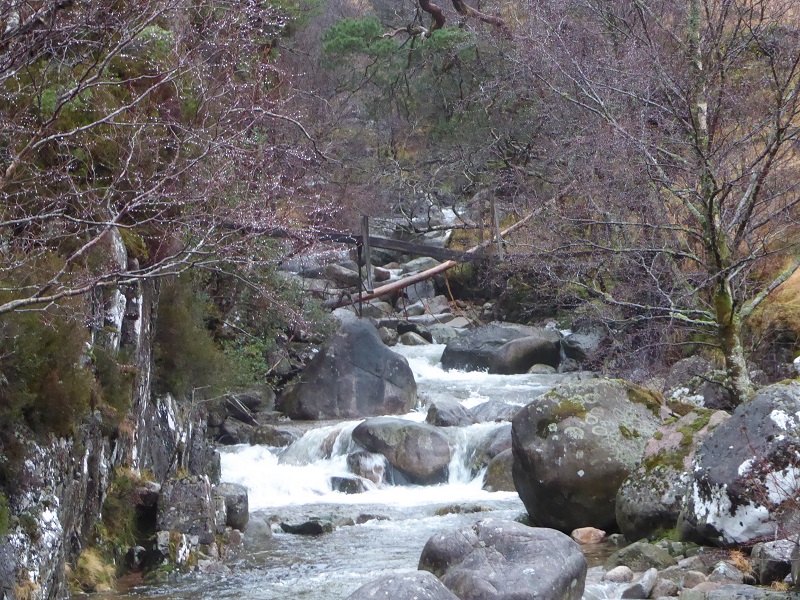
“The location of the intakes, especially the intake to the west, is in a very confined gorge area – detailed plans should be included to show the extent of excavations required to access and work in these areas.”
This raises the question whether its possible to construct a hydro intake here without destroying the gorge? SEPA highlighted similar issues for the Allt Fhaolain intake, which they also visited:
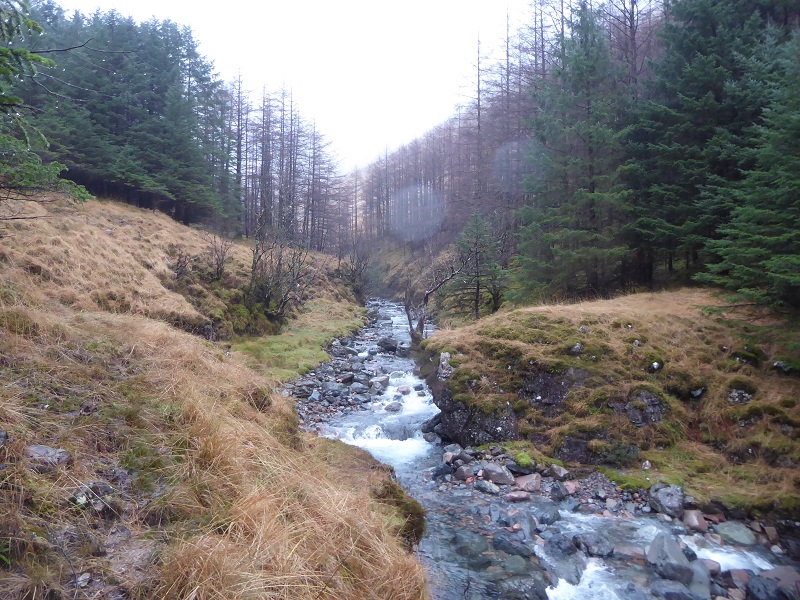
The challenge will be even greater in the much larger gorge where its proposed to located the Allt Mheuran and which was not included in the SEPA site visit:
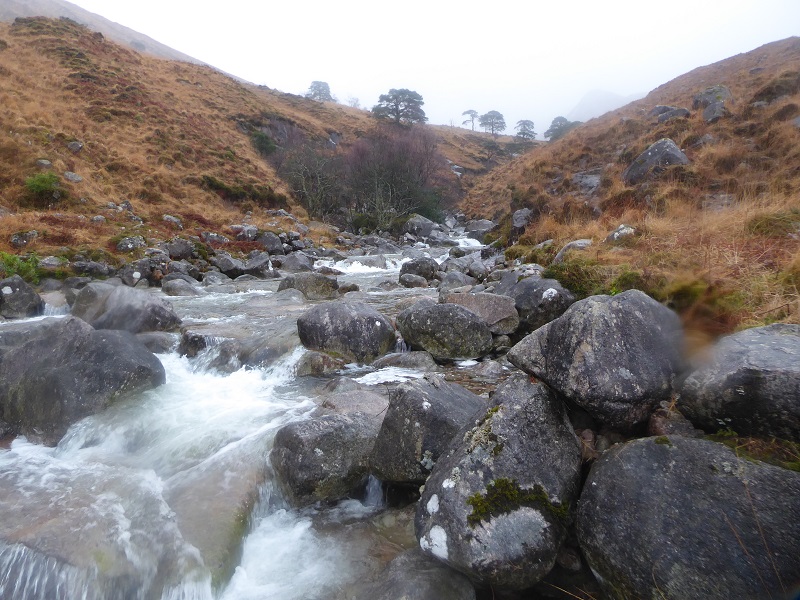
Concerns about whether it would be possible to construct an intake in the Allt Mheuran gorge without irreparably damaging it led to some Councillors who supported the other hydro schemes to vote against it. The Allt Mheuran was the most narrowly approved of all the Etive schemes – and we still have NO idea how Mr Dickins will address the construction challenges
SEPA indirectly confirm in their email that constructing a pipeline across the slope to the Allt Mheuran intake (slope on right in photo above) and Allt Charnan intake, where there is a similar slope, is likely to be impossible without doing irreparable damage in a comment on the Allt Fhaolain scheme.
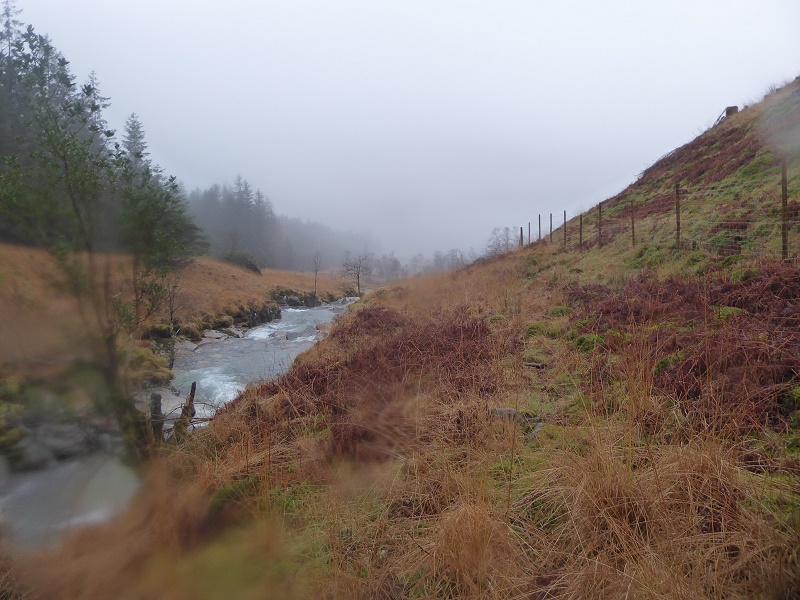
I commented on the technical challenges of installing the pipeline here back in December (see here) when I commented as follows::
“Its proposed the pipeline will be buried in the bank on the west side of the river. In the case of the Allt Fhaolain, for much of the way the bank is broad with plenty of space to dig a pipeline but in one place it narrows. The Construction Method Statement talks about 20m working corridors. That appears impossible where the bank narrows (photo above). The Planning Application appears to say nothing about this challenge, how they would avoid destabilising the slope above or how they would prevent excavated material from washing into the river. The Planning Authority needs to request detailed plans for how Dickins Hydro proposes to overcome this challenge before proceeding further with the Application.”
SEPA’s email confirms that I was, basically, right about the line of the pipeline:
“We would be likely to be supportive of any proposal to move the penstock further away from the river and to within the same corridor as the access track. If this is the case the penstock would need to ascend the bank that the existing forest track is located on top of and it should do that at a location that is as far away as possible from the river and over as short a length as is practical.”
In other words, the original pipeline route approved by Highland Council was fatally flawed. Again, this issue – and similar issues at the Allt Charnan and Allt Mheuran – should have been addressed before this scheme was ever put to Committee for approval. Unfortunately, with the drive to approve planning applications in as short time as possible, frontline staff are forced to go along with poor proposals and hope they can pick up the pieces afterwards.
Its very positive, however, that SEPA now appear to be strongly on the case and laying out basic requirements in black and white:
- The penstock working corridor (ie both sides) needs to be marked out, not just the central
line. This is needed to ensure that the 20 m corridor is observed and impacts are
minimised. A similar approach needs to be taken with other temporary works such as
borrow pits, laydown areas and construction compounds. - Watercourses should be reformed over the top of the restored penstock route – they must
not be culverted underneath.
SEPA’s email suggests Dickins Hydro Resources are a long way yet from convincing them, and through them Highland Council, that appropriate plans are in place which would enable construction on the proposed hydro schemes in Glen Etive to start. I don’t think this is an accident. In my next post I will take a further critical look at Dickins Hydros competence and experience to deliver hydro developments.
Meantime, if you live in Highland Region you can help by bringing these issues to the attention of your local councillors and asking them to help ensure that all planning conditions agreed by the Council for Glen Etive are fully enforced.
There is also some doubt as to whether the grid connection was in place within the required timescale and whether an application to the FiTS scheme was submitted before it closed. This latter point could make the hydro schemes unviable.
It is truly amazing that all these concerns were not addressed before Highland Council approved these schemes! It is strange that these most important matters are not conducted in the correct order. Where does all this the Grampian Club regarding their Club hut Inbhirbhaolain?
This is an excellent article which helps me understand many of the planning issues which have clearly been bulldozed through in previous similar constructions. Holding developers to account is vital but even more important is to ask the very obvious questions like; ‘why is this set of developments needed and who is likely to benefit’ and ‘is there any other way to achieve similar outcomes of energy production with less impact elsewhere’?
I fear subsidies and a long line of companies/Directors may well be the principle feature in all this as certainly Glen Etive won’t benefit!
It always makes me wonder whether the power output proposed could be better provided by a number of wind turbines in a less sensitive area closer to the demand? Certainly they could be provided quicker with less disruption all round. Why rip up such a sensitive area? I’ll bet revenue to the landowner is the overwhelming factor in the drive to have hydro in Glen Etive.
Yes, all the power could I understand be produced by one wind turbine! The enormous sums given to the owner of the power scheme and through them to the landowner would be much better spent on insulating houses in the Highlands to bring down fuel bills.
Very informative. Seems to be following the normal procedure where promises are made, which do not stand up to scrutiny, to obtain permission and when the work starts the developers strive to get away with what they can to maximise profit, which is what the whole thing is about anyway…